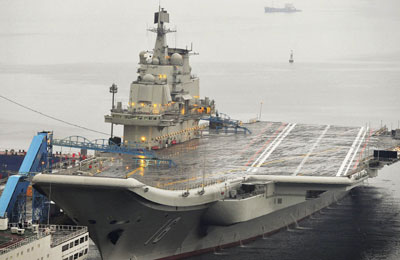
China launches aircraft carrier; Japan warned
Beijing , September 25, 2012
China sent its first aircraft carrier into formal service on Tuesday amid a tense maritime dispute with Japan, in a show of naval ambitions that could spur regional worries.
The launch came even as Vice Foreign Minister Zhang Zhijun warned his Japanese counterpart that China will not tolerate any violations of its sovereignty as the two met in a bid to ease tensions over a territorial dispute.
China's Ministry of Defence said the newly named Liaoning aircraft carrier would "raise the overall operational strength of the Chinese navy" and help Beijing to "effectively protect national sovereignty, security and development interests".
In fact, the aircraft carrier, refitted from a ship bought from Ukraine, will have a limited role, mostly for training and testing ahead of the possible launch of China's first domestically built carriers after 2015, analysts say.
But China cast the formal handing over of the carrier to its navy as a triumphant show of national strength -- at a time of bitter tensions with neighbouring Japan over islands claimed by both sides.
Sino-Japanese relations deteriorated sharply this month after Japan bought the East China Sea islands, called Senkaku in Japan and Diaoyu in China, from their private owner, sparking anti-Japan protests across China.
"China will never tolerate any bilateral actions by Japan that harm Chinese territorial sovereignty," Zhijun said. "Japan must banish illusions, undertake searching reflection and use concrete actions to amend its errors, returning to the consensus and understandings reached between our two countries' leaders."
The risks of military confrontation are scant, but political tensions between Asia's two biggest economies could fester.
For the Chinese navy, the addition of carriers has been a priority as it builds a force capable of deploying far from the Chinese mainland.
China this month warned the US, with President Barack Obama's "pivot" to Asia, not to get involved in separate territorial disputes in the South China Sea between China and US allies such as the Philippines.
US Secretary of State Hillary Clinton in turn urged China and its Southeast Asian neighbours to resolve disputes "without coercion, without intimidation, without threats and certainly without the use of force".
The timing of the carrier launch might be associated with China's efforts to build up patriotic unity ahead of a Communist Party congress that will install a new generation of top leaders as early as next month.
Narushige Michishita, a security expert at the National Graduate Institute for Policy Studies in Tokyo, said he thought the timing had nothing to do with the islands dispute.
"NOT CUTTING EDGE"
"China is taking another step to boost its strategic naval capability," he said. "If they come to have an operational aircraft carrier, for the time being we are not super-concerned about the direct implications for the military balance between the US and Japan on the one hand, and China on the other. This is still not cutting edge."
The East China Sea tensions with Japan have been complicated by the entry of Taiwan, the self-ruled island that Beijing calls an illegitimate breakaway, which also lays claim to the islands.
Japanese Coast Guard vessels fired water cannon to turn away about 40 Taiwan fishing boats and eight Taiwan Coast Guard vessels on Tuesday.
Japan protested to Taiwan, a day after it lodged a complaint with China over what it said was a similar intrusion by Chinese boats.
Taiwan has friendly ties with Japan, but the two sides have long squabbled over fishing rights in the area. China and Taiwan both argue they have inherited China's historic sovereignty over the islands. - Reuters







